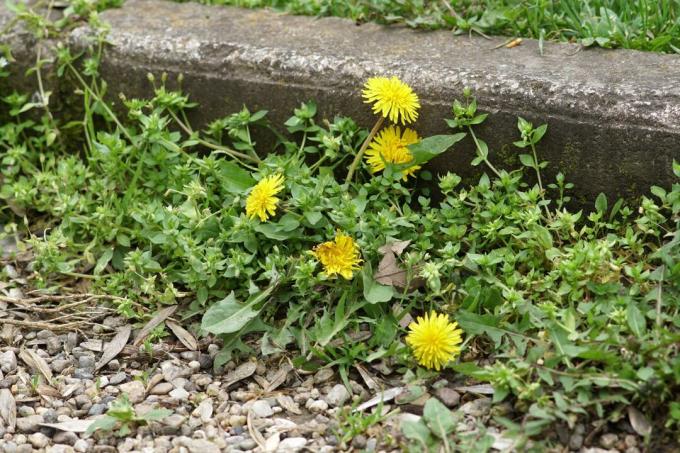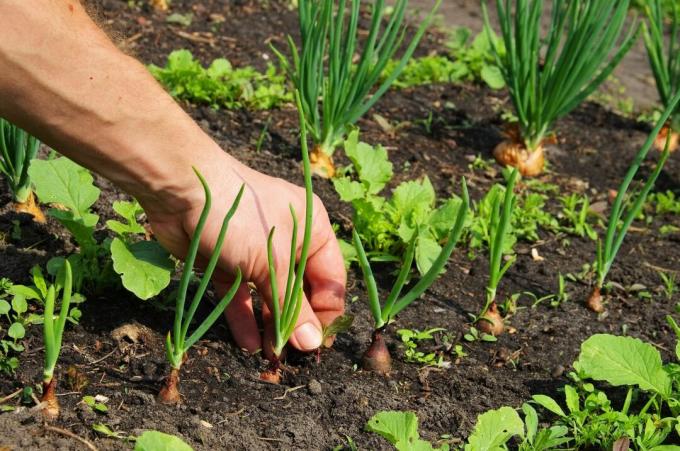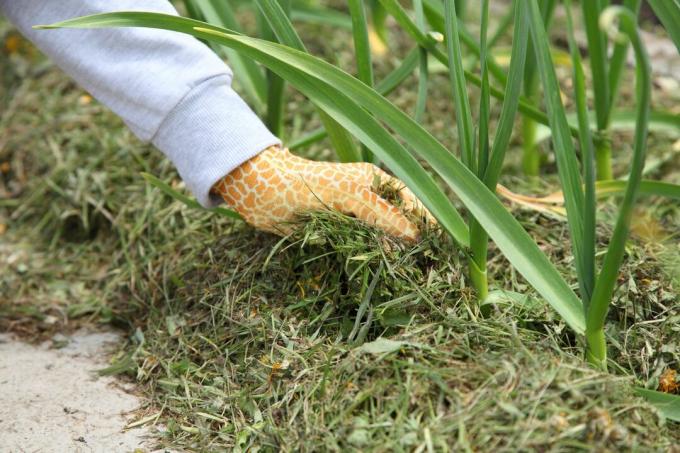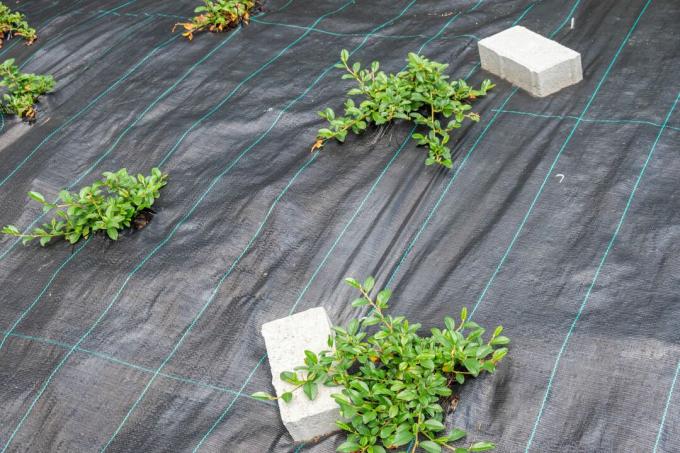Weeds can be found in every garden, no matter how well cared for, and usually grow faster than the ornamental plants or vegetables in the bed. Here are the top tips for pulling weeds.

By weeds, weeds or "weeds" we mean plants that invade lawns, flower pots and vegetable beds without our advocating their presence there. They often compete with our crops for water, light and nutrients, so their presence negatively impacts our success as gardeners. If you can't somehow prevent the plants from emerging, you have to weed them regularly. That's why we've put together tips and tricks for weeding for you.
Contents
- Pulling weeds: These weeds grow particularly frequently
- When is the best time to weed?
- The right tool for weeding
- Pulling weeds: how to do it?
- Removing weeds from the lawn: tips and tricks
- Home remedies for weeds
- Remove weeds from joints
- Remove weeds permanently
Pulling weeds: These weeds grow particularly frequently
- Creeping thistle (Cirsium arvense)
- field horsetail (Equisetum arvense)
- bindweed (Convolvulus arvensis)
- plantain (Plantago major)
- buckhorn (Plantago lanceolata)
- nettle (Urtica dioica)
- speedwell (Veronica spec.)
- french herb (Galinsoga parviflora)
- goutweed (Aegopodium podagraria)
- Groundman (Glechoma hederacea)
- buttercup (Ranunculus)
- dandelion (Taraxum spec.)
- moss
- couch grass (Elymus repens)
- sorrel (Rumex acetosa)
- Chickweed (Stellaria media)

Tip: There is no official group of “weeds”, only we humans call them that when they bother us. Native wild plants in particular are of great value to our ecosystem. So you shouldn't generally demonize these plants and simply let them grow in places where they don't bother you. Wild herbs can also be integrated perfectly into a natural environment flower meadow and can develop an unexpected beauty there.

When is the best time to weed?
A general time of year or day for weeding cannot be recommended. Rather, the optimal weeding time depends on the factors soil moisture and growth stage of the weeds. A hard-working gardener pulls the weeds about once a week and saves a lot of work in the process: Because who the Removed plant before flowering and seed formation, can spread and hence future weeding work to reduce.
- soil moisture: The soil should be moist for weeding. This allows the plants to be pulled out easily without tearing off the roots, from which they can eventually grow back. If the soil is too dry and very hard, it can be moistened with a garden hose or a watering can. If the subsoil is too wet, you should wait until it has dried a bit so that the soil does not stick to tools and hands.
- Growth stage of weeds: The smaller the weeds when weeding, the better. However, you should be sure which plants are being plucked out, because often the weeds and the crop plants in the cotyledon stage are difficult to distinguish. It can therefore make sense to wait until 4 to 6 leaves have formed on it.
- Before self-seeding: In order to prevent the weeds from self-seeding, they should be weeded at the latest when they bloom. However, weed blossoms also provide a valuable food source for insects and attract pollinators. The right timing is important here: If possible, wait as long as possible for the positive Effects of flowering can still be exploited and remove the plants before seeds are formed have. This is particularly successful with solitary, large weed plants.

The right tool for weeding
There are many different devices available for weeding. Depending on personal preferences and depending on where the weeds are to be removed, the right device is selected. However, the most important tool is still the hands. Wear gardening gloves when pulling weeds to protect against injury and debris. A weed hoe, weeding fist, pickaxe, weeding sling, flower claw or a shovel can be used for this purpose. A weed puller is ideal for removing deep-rooted weeds such as dandelion or sorrel. Knee pads are recommended for this, after all you spend most of the time on all fours when weeding. For larger areas there are also devices with a long handle, such as various hoes and weeders.

Pulling weeds: how to do it?
Weeding is one of the less popular tasks in the garden. Nevertheless, it is very important and should be done regularly. Here's how to do it:
- Get an overview of the weed population: Which weeds are present? How tall are you? You might even find a few edible weeds in the garden.
- If necessary, the soil should be moistened so that the weeds can be pulled out together with the roots.
- Gather all the tools: bucket, hoe, shovel, gardening gloves, and sunscreen if needed.
- Weeds with seed heads must be collected separately if the remaining plants are to be composted. However, if you want to be able to get rid of the weeds in the bio bin or as animal feed, this separation is not necessary.

- Now it can start. Be sure to always remove the root as well. Otherwise the plants will grow back in no time.
- Some weeds such as horse thistle, dandelion and sorrel are extremely stubborn. Their taproot must be carefully pricked out.
- Even root weeds such as couch grass and ground elder must be dug up completely so that they no longer grow back.
- After weeding, you should regularly check whether new weeds are spreading again and whether you need to weed them again.
- The "harvested" weeds should dry out completely in the sun before composting, for example on a paved surface or on a black film. Otherwise the storage roots in the compost will simply continue to grow.

Back-friendly weeding: Pulling weeds in a permanently stooped position is an unusual and demanding strain on the back. You should therefore make sure that you adopt a back-friendly posture while working. For example, kneel on only one leg so that blood circulation is not restricted and you can stand up easily. Standing work can also be done when circumstances permit, using a long-handled hoe. Raised beds are very easy to work with and easy on the back, as the working height is adapted to the body size.

Tip: Hoeing between plants not only removes weeds, but also reduces water loss from the soil by disrupting the rise of water in soil capillaries. The water no longer reaches the surface where it would evaporate. Hence the old adage “chopping once saves watering three times”.

Removing weeds from the lawn: tips and tricks
Weeds can not only spread in vegetable or flower beds. Weeds also appear regularly in the lawn and need to be removed.
Tip: Weeds always germinate in the emergence phase of the lawn grasses. These cannot be removed without damaging the lawn seedlings. However, removing the weeds is not absolutely necessary. During the first mowing, the plants that do not tolerate pruning usually disappear by themselves. Only root weeds in the lawn should be prevented and their roots already before lawn seeding remove thoroughly.
- prick weeds: The deep-rooted weeds dandelion and yarrow are best removed with a weed puller.
- Good care: A well-manicured lawn is less prone to the spread of weeds. Water the lawn if necessary and fertilize the lawn regularly, for example with our Plantura organic lawn fertilizer. The long-term fertilizer is suitable for spring and summer fertilization and supplies the lawn with nutrients for around 3 months.

Organic lawn fertilizer 10.5 kg (sack)
- Organic lawn fertilizer for a healthy & lush green lawn
- For spring and summer fertilization with a 3-month long-term effect
- 100% natural & animal-free ingredients - safe for pets & garden animals
- Correct mowing: Regular mowing also plays an important role. A cutting height of 4 to 5 cm has proven itself, as this still casts enough shadow on the ground to prevent the weed seeds from germinating. It is very important to mow weekly during growth phases, even if the lawn may not have grown that much yet. Otherwise the leaves of the wild herbs lie flat on the ground, escape the mower and can spread.

- Liming: Liming helps against unwanted plants in the lawn, such as moss. Our Plantura Organic Lawn & Garden Lime Brings overly acidic soils back into a pH range that is more favorable for grasses. When used correctly, it improves the activity of soil life and thus soil fertility.

Organic Lawn & Garden Lime 15 kg
- High-quality, fine-grained lawn & garden lime for improved soil fertility
- Against weeds and moss: Brings acidic soil back into balance
- Suitable for spreaders and easy to spread - harmless to pets and garden animals
- Acceptance: Orderly gardeners don't like to see weeds in the lawn. A weed-free lawn in your own garden is sooner or later an unrealistic idea. The comparison to golf and sports field lawns or English lawns doesn't help either, because with these areas other seed mixtures and certain care products are used and a high, often environmentally harmful effort operated. If you can enjoy one or the other wild plant in your lawn, you are doing yourself and the environment a favor.

Tip: Scarifying is not a helpful measure against weeds in the lawn, but can even further spread rhizomatous weeds such as white clover and couch grass. Even moss is not permanently removed with it. If you set the scarifier too low and try to use it to get wild herbs out of the ground, you will even damage the lawn. The actual goal of scarifying, namely stimulating the branching of the lawn grasses by superficially damaging the grass roots, is missed.
Home remedies for weeds
If manual weeding is too strenuous, you might want to use other methods. Here are some home remedies and alternative methods for weed control:
- Salt and Vinegar: Although these home remedies work against weeds, they also have negative effects on other plants. When using it, you have to be careful that the cultivated plants are not accidentally destroyed at the same time. In addition, these products can accumulate in the soil because they break down very slowly - which can result in nothing growing in that spot at all. Citric acid, baking powder or baking soda also belong to such home remedies, but these are not permitted for use as herbicides. Salt and vinegar, on the other hand, are allowed.
- flaming: The goal here is to heat the weed so much that the proteins denature. This can be recognized by the fact that the leaves turn light green. Since the flaming devices are usually operated with gas and reach high temperatures, you should definitely be aware of the risk of fire. This method is a good option, especially on paved surfaces.
- Hot water: Hot water has the same effect as the heat when flaming. Residual water, such as hot potato or pasta water, can be used here.
- nettle brew: The citric acid contained in the stinging nettle brew works against weeds if the brew is regularly poured over the plants to be removed.
- ground cover: Ground covers are a good way to prevent weeds, as they have a strong suppressing effect. Due to the lack of space and light, weeds hardly have a chance to grow through the closed plant cover. Before the ground cover is planted, all weeds must of course be removed first, otherwise they will grow through.

Remove weeds from joints
When the weeds spread in the joints of the paved terrace or in the garage entrance, it quickly looks unkempt. There are the following methods to remove the weeds from the joints:
- A joint scraper is probably the most environmentally friendly. Make sure the device has a sharp blade and a handle that is comfortable to hold. With this, the weeds are gradually scraped out of one joint after the other.
- The weeds can be scraped out of the joints with a joint brush with particularly stiff bristles.
- Other effective methods are the flaming already mentioned and hot water.
- The weeds can be sprayed out of the joints with a high-pressure cleaner. At the same time you can clean the pavement or the terrace stones.
Tip: In principle, raw materials and herbicides must not be applied to paved areas, as these Agents are quickly washed off the surface and get into the groundwater, where they become contaminants to lead.

Remove weeds permanently
Permanently removing weeds is almost impossible. Because weed seeds can come from anywhere with the wind or by animals. But there are ways to suppress the germination and spread of weeds right from the start:
- fleece and fabric: Free ground can be covered with an opaque plant fleece or fabric. This way no light reaches the weed seeds and germination is prevented. In this way weeds are suppressed and soil life can still develop.
- mulch layer: A layer of mulch made from natural materials inhibits weed growth.
- Regular weeding and hoeing: Regular weeding removes weeds before they set seed. Thus, the seed supply in the soil is at least not expanded and newly germinating weeds are removed promptly.
- Fill joints: A closed pavement surface can be created with joint sand or weatherproof mortar, especially with permanently elastic joint sand, so that no more plants can grow there.

elecampane (Inula helenium) is an interesting native weed. You can find out more about this plant in our special article.
Register now for the Garten-Post and receive great tips, seasonal trends and inspiration on everything to do with the garden from our expert every week.



